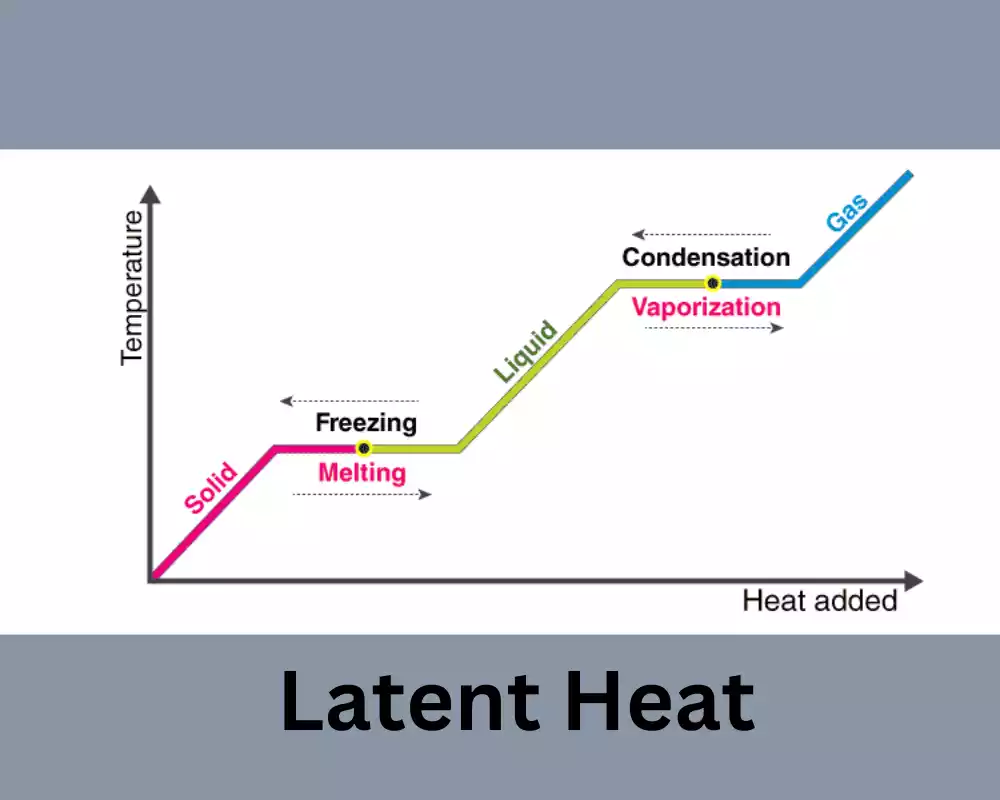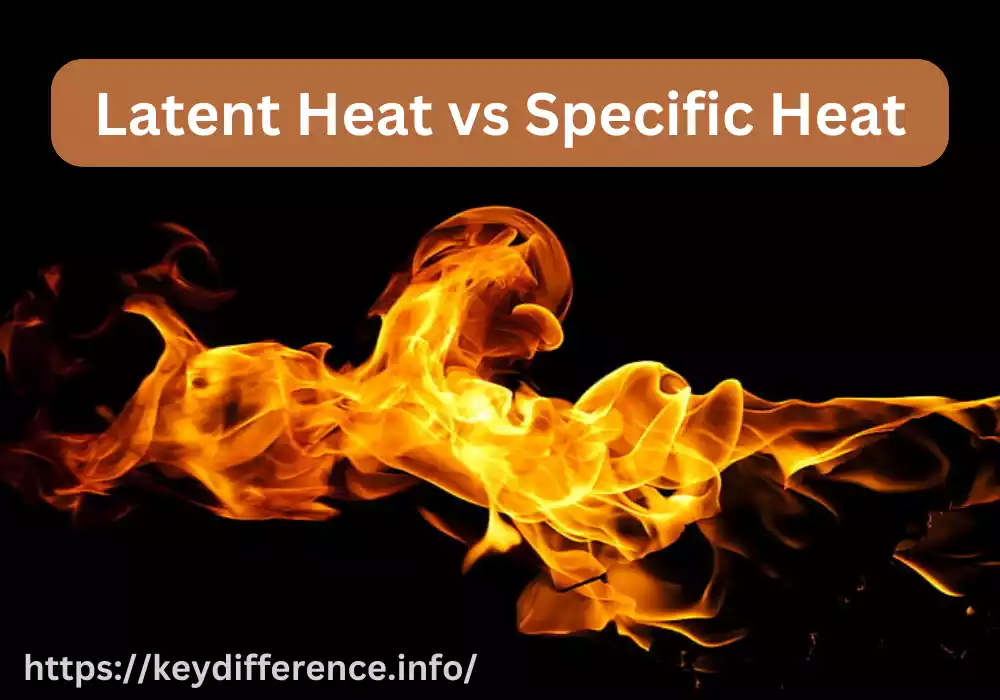Latent Heat and Specific Heat
The thermodynamics of heat transfer is characterized by the concepts of latent and specific heat. The latent heat is the energy released or absorbed during phase transitions such as the conversion of liquids or solids into gases.
The latent heat is crucial in phase transitions. It provides or removes energy that can change a substance’s state without changing its temperature. By boiling water, for example, energy is supplied to turn liquid water into vapor without raising its temperature. Latent heat can be used in many applications including cooling and heating systems, energy storage, and even weather phenomena such as cloud formation.
Specific heat, on the other hand, measures the ability of a material to store thermal energies. The amount of heat needed to increase the temperature of any given material is quantified. The specific heat value of substances varies, which influences their thermal behavior and properties. Understanding the specific heat value is essential for designing heating and cooling systems that are efficient, choosing materials with desirable thermal properties, and optimizing energy consumption in different processes.
It is important to distinguish between latent and specific heat as these terms describe two different aspects of the heat transfer process. Specific heat is concerned with temperature fluctuations, whereas latent heat is mainly focused on phase changes. Engineers, scientists, and researchers can design more efficient systems and materials by understanding and applying the concepts.
Importance of understanding the distinction between Latent Heat and Specific Heat
Understanding the distinction between latent heat and specific heat is of significant importance due to the following reasons:
- Efficient Energy Transfer: Latent heat and specific heat represent different mechanisms of energy transfer. Latent heat is involved in phase changes, while specific heat relates to temperature changes. By understanding their distinction, we can effectively manage and optimize energy transfer processes. This knowledge allows us to design efficient heating, cooling, and thermal energy storage systems, leading to improved energy utilization and conservation.
- Material Selection and Performance: Different materials have varying latent heat and specific heat values. Understanding their distinctions enables engineers and scientists to select materials with desired thermal properties for specific applications. For instance, materials with high latent heat are suitable for energy storage applications, while those with high specific heat can provide better temperature stability in certain systems.
- Climate and Weather Phenomena: The latent heat is a key factor in the climate and weather. Processes such as evaporation, condensation, and cloud formation involve the exchange of latent heat. Accurate understanding and modeling of these processes are vital for weather prediction, climate studies, and understanding the Earth’s energy balance.
- Industrial Processes and Material Transformation: Many industrial processes involve phase changes and temperature changes. Differentiating between latent heat and specific heat allows for better process optimization, material selection, and control. This knowledge is essential in fields such as materials science, manufacturing, chemical engineering, and food processing.
- Advancements in Energy Systems: As we strive towards sustainable energy systems, understanding the distinction between latent heat and specific heat becomes increasingly important. It enables the development and integration of phase change materials, efficient thermal energy storage systems, and innovative heat transfer technologies that can enhance energy efficiency, reduce environmental impact, and support renewable energy integration.
Definition of Latent Heat
The latent heat is the heat energy absorbed and released by a substance during phase changes, for example, when a substance converts from a solid to a liquid or gas without changing its temperature. The energy needed to form or break intermolecular bonding during the phase transition.

The temperature of the substance does not change during phase changes despite adding or removing heat. The energy is being used to change the motion and arrangement of particles, not their average energy. Energy is stored in the molecular structure of a substance as potential energy.
When a solid undergoes melting and becomes a liquid, for example, the energy provided is used to weaken the intermolecular force holding the particles, allowing them more freedom to move. Similar to the freezing process, latent heat is released as particles are arranged in an orderly manner and intermolecular force increases.
Definition of Specific Heat
Specific heat (also referred to as specific heat capacity) measures how much energy it takes to raise one kilogram or degree Celsius of temperature by one Kelvin or degree Celsius – it thus represents an object’s intrinsic thermal properties. The specific heat can be expressed either in joules/kg/degC or joules/gram/degC. The term “specific heat” refers to the energy required to increase an object’s surface temperature exactly by the same amount.

Differences in atomic and molecular structures among different materials can create wide differences in specific heat values of different substances, with higher specific heat values necessitating greater amounts of energy needed to increase temperature than low specific heat value materials due to greater capacity to store thermal energies in these substances.
Calorimetry or using existing data are two ways of estimating specific heat. This parameter plays an integral part in designing heating and cooling systems as well as calculating heat transfer rates, among many other applications.
Note that materials going through phase transition or chemical reaction can have their specific heat change with temperature; different specific heat values could apply at various temperatures in such situations.
Characteristics of Latent Heat
Latent heat is characterized by:
- Phase Change Energy: The energy released or absorbed during phase changes of substances, like the conversion from liquid to solid or liquid to gas is called latent heat. The transformation from one substance to another is not accompanied by a temperature change.
- Temperature stability: The temperature remains constant during a phase transition. The energy used in adding heat or removing it is actually being used to form or break intermolecular bonding, not raising or decreasing the temperature.
- Latent Heat: This is energy stored within the molecule structure of any substance. Energy is stored in the particles of a substance as potential energy when energy is absorbed by a substance during phase changes.
- Intermolecular bonding: The strength of the intermolecular force is directly related to latent heat. It requires energy to release these forces when particles transition from one state to another.
- Specific to Each Substance: Latent Heat Values for Each Substance. Different substances will have different values. The molecular and atomic properties of each substance determine the amount of energy needed to change between phases.
- Importance in Thermal Processes: Latent Heat is important in thermal processes. This energy is used in many applications, including thermal storage, cloud formation, precipitation and industrial phase-change processes.
- Reversible process: The latent heat can be reversed. The energy released by a phase shift is also absorbed in the reverse process.
- Thermodynamic Property: Latent Heat is a thermodynamic property of a material. The term describes energy exchanges associated with phase changes in a substance, regardless of how or under what conditions they occur.
The characteristics of latent energy are important in understanding phase change behavior. They have implications for thermodynamics and other fields, such as meteorology, materials, and energy science.
Characteristics of Specific Heat
Specific heat is characterized by:
- Temperature change: The heat required to raise the temperature of a particular object is called specific heat. It is the amount of heat required to alter the temperature.
- Energy Release or Absorption: A substance releases energy when it cools, but absorbs energy during heating. Specific heat values quantify the energy required to change a temperature.
- Different materials: Different materials have different specific heat values. The molecular structure of each substance determines its specific heat capacity.
- Heat Capacity: Specific heat can be equated to heat capacity, the quantity of energy needed to increase the temperature of one kilogram of a substance by a degree Celsius.
- Important for Engineering: It is important to understand specific heat when designing heating and cooling systems. This includes selecting materials that have the desired thermal properties and calculating heat transfer rates.
- Temperature-Dependent: Specific heat can vary with temperature, especially for substances undergoing phase changes or chemical reactions. Different specific heat values can be applied to different temperatures in such situations.
- Heat Transfer Calculations: The specific heat used is used to determine the energy needed to heat substances or the rate of heat exchange in systems.
- Mass-dependent property: The specific heat of a substance is a mass-dependent property. The total energy needed to change the temperature increases as the mass of the substance increases.
The characteristics of specific temperatures are crucial to understanding and predicting thermal behavior in different processes and systems. This allows engineers and scientists to optimize energy use, design efficient heating systems and cool down, as well as select the appropriate material for specific applications.
What is the formula for calculating Latent heat?
The formula for calculating latent heat depends on the specific phase change involved. Here are the formulas for the most common phase changes:
Latent Heat of Fusion (L):
The formula to calculate the latent heat of fusion is given by:
L = Q / m
where:
L is the latent heat of fusion,
Q is the amount of heat energy absorbed or released during the phase change (in joules), and
m is the mass of the substance undergoing the phase change (in kilograms).
Latent Heat of Vaporization (L):
The formula to calculate the latent heat of vaporization is given by:
L = Q / m
where:
L is the latent heat of vaporization,
Q is the amount of heat energy absorbed or released during the phase change (in joules), and
m is the mass of the substance undergoing the phase change (in kilograms).
In both cases, the latent heat is calculated by dividing the amount of heat energy (Q) by the mass (m) of the substance. The specific values of latent heat of fusion and latent heat of vaporization for different substances can be found in reference tables or obtained through experimental measurements.
What is the formula for calculating Specific Heat?
The formula for calculating specific heat depends on whether you are considering specific heat capacity (C) or molar specific heat capacity (Cm). Here are the formulas for each:
Specific Heat Capacity (C):
The formula to calculate specific heat capacity is given by:
Q = m * C * ΔT
where:
Q is the amount of heat energy absorbed or released (in joules),
m is the mass of the substance (in kilograms),
C is the specific heat capacity of the substance (in J/kg°C or J/g°C),
ΔT is the change in temperature (in degrees Celsius or Kelvin).
Molar Specific Heat Capacity (Cm):
The formula to calculate molar specific heat capacity is given by:
Q = n * Cm * ΔT
where:
Q is the amount of heat energy absorbed or released (in joules),
n is the number of moles of the substance,
Cm is the molar specific heat capacity of the substance (in J/mol°C or J/mol*K),
ΔT is the change in temperature (in degrees Celsius or Kelvin).
Difference Between Latent Heat and Specific Heat
Here’s a comparison table highlighting the key differences between Latent Heat and Specific Heat:
| Aspect | Latent Heat | Specific Heat |
|---|---|---|
| Definition | Heat energy absorbed/released during phase transitions | Heat energy required to change temperature |
| Phase Transitions | Melting, freezing, vaporization, condensation | N/A |
| Energy Exchange | Hidden energy exchange | Sensible heat exchange |
| Unit of Measure | Joules per kilogram (J/kg) | Joules per kilogram per degree Celsius (J/kg°C) |
| Temperature Change | No change in temperature | Temperature change |
| Significance | Drives phase changes in matter | Influences temperature changes |
| Magnitude | Larger energy exchange | Smaller energy exchange |
| Examples | Ice melting, boiling water | Cooking, climate control |
| Application | Cooking, phase change processes | HVAC systems, material selection |
The similarities between Latent Heat and Specific Heat
Although latent and specific heat concepts are different, there are some similarities between them:
Latent Heat and Specific Heat both involve energy transfer. Both processes involve the absorption or release of heat energy.
Latent and specific heat is measured as units of energy per mass at a given temperature. Latent heat can be measured as joules/kg (J/kg), joules/g (J/g), or in joules/grams (J/g), whereas specific heat measured in joules/kg per degree Celsius or in joules/gram per degree Celsius.
Values of latent and specific heat depend on the materials being studied. The latent and specific heat values of different substances are affected by variations in the molecular structure or atomic composition.
The heat capacity is influenced by both latent and specific heat. The heat capacity is the energy needed to increase the temperature of the substance. Specific heat relates to the amount of heat energy per unit mass. Latent heat also relates to the heating capacity as it is the energy needed to change the phase of a substance.
Both latent heat and specific energy are important for thermodynamic processes. These processes are crucial to understanding energy transfer and phase change in different systems.
Although latent and specific heat differs in many ways, they are similar in that both play a role in the transfer of energy and in thermodynamics.
Summary
Latent heat is a concept that is distinct from specific heat in terms of heat transfer. The latent heat is the energy that’s absorbed during phase transitions, like liquid into gas or solid-to-liquid conversions. The term is used to describe the change of state without temperature. The specific heat is the heat energy needed to increase the temperature by a specified amount. The material’s thermal energy storage capacity is quantified.
Latent and specific heat differ in terms of their representation, measurement, and application. Specific heat is related to processes that involve temperature changes, whereas latent heat involves phase change processes. Temperature changes are caused by heating and cooling, not phase changes.

